History of the North German Lloyd - 1898
Introduction
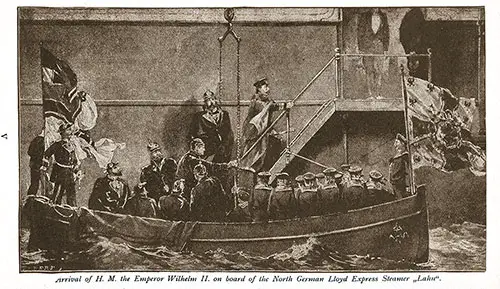
Arrival of His Majesty, the Emporor Ilhelm II on board the North German Lloyd Express Steamer SS Lahn. GGA Image ID # 1ddfd00169
The History of the North German Lloyd, 1898 is based on the book "Guide Through North and Central America" by Norddeutscher Lloyd.
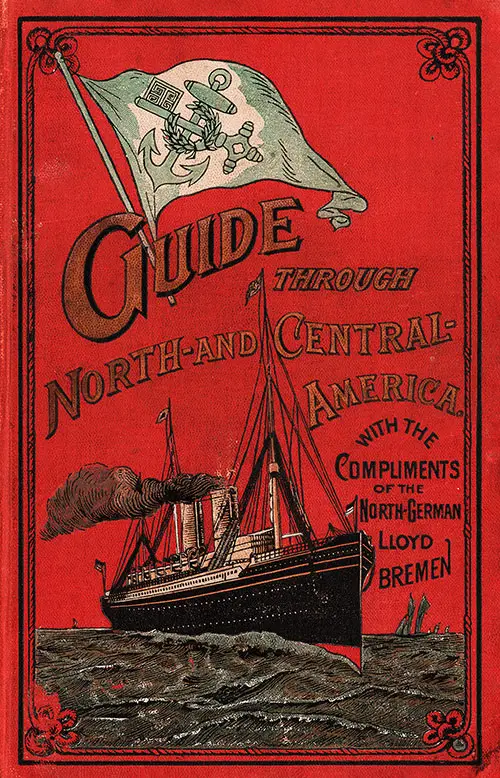
Front Cover, North German Lloyd Guide Through North America - 1898. GGA Image ID # 1e8c193d29
When a historian of the future undertakes to write the history of Germany's transoceanic trade, an important chapter in his work will doubtless be filled by the annals of the North German Lloyd S. S, Co. of Bremen.
The following short sketch of the Company's development will illustrate how enterprise and broad-minded views have, in the comparatively brief period of a few decades, succeeded in obtaining the renowned and dominant position for Lloyd, which it now enjoys in the old and the new world.
The North German Lloyd, whose vessels now unite the four corners of the globe, was founded in 1857, exactly ten years after the period when, for the first time, a steamer, the SS Washington, had crossed the Atlantic on her voyage from Bremen to New York.
The service of the Lloyd, which in the beginning was carried on by but three small steamers, consisted during the first year only of one line to England. However, already in the following year, the New York line (the main object of the foundation of the Company) was opened by the despatch of the Bremen with full cargo, some -passengers, and one cabin passenger.
The First Decade of Service
In a remarkable feat, the Lloyd Company was entrusted with the carriage of the Anglo-American mails in 1859. This significant milestone, coupled with the Company's growing expertise in the cargo and passenger business, and its reputation for regularity and safety, set the stage for the rapid expansion of its fleet.
By 1865, the number of passengers transported by the Company's steamers had reached an impressive 9,714. The following year, a weekly boat dispatch became necessary, and by 1867, a mere ten years after its establishment, the Lloyd Company was in command of a fleet of 14 steamers. Eight of these were dedicated to the New York line, while the remaining six served the English line. The Company's influence was further demonstrated by the 47 voyages to America and 127 to London and Hull in 1867.
These figures proved the prosperity of the undertaking, and the Directors, anticipating the influence that the development of the Company would later on exercise on Germany's transoceanic interests, justly recognized it as their duty to further promote the foreign relations of the fatherland by creating new services and extending those already existing.
This period marked the first signs of the subsequent powerful growth of German industry and commerce, and the Lloyd Company played a significant role in this. As the lack of regular steamship communication became a pressing issue, the Company's foresight and actions were instrumental in addressing this, contributing to the growth of German industry and commerce.
The Second Decade
The second decade of the history of the North German Lloyd bears full testimony to the fact that the Company has spared no effort to accommodate itself to the altered conditions of trade. In 1868, relations with North America were extended through the opening of the Baltimore line.
In Baltimore, the arrival of the first steamer was celebrated as an event of considerable importance. The place was en fête. Schools, Markets, the Customs House, and most of the shops were closed. A procession headed by the Governor and the dignitaries of both the State and the city, accompanied by United States infantry, cavalry, and artillery and representatives of the different trades, clubs, and societies, paraded the town. At a banquet that followed, great results were confidently predicted.
The Franco-German War
We now arrive at an anxious year for the Company. At the outbreak of the Franco-German war, the German ports were declared in a state of blockade. The French fleet's superiority necessitated that the Company's ships in foreign ports be ordered to remain there and those on their way home be warned of their danger and directed to safe, neutral ports. Foreign steamers had to be chartered, and other heavy expenses were incurred. But victory on land limited the period of the severest trial to about three months.
Gradually, the ships left their foreign quarters and, taking a northerly course around Scotland, ran into one of the English east coast ports while awaiting an opportunity to slip across to the Weser. In October of the first year of the war, the Hansa even re-opened the transatlantic service with full freight and a large number of passengers.
To the captains and officers of the Lloyd employed on these hazardous expeditions, the North Sea was as his native forests are to the Indian. They cut through the blockading cordon northwards and made their way round the dangerous coast of Scotland. They steamed down the channel right through the French fleet, wrapped in friendly fogs. For policy reasons, however, it is well to suppress all details of the stirring incidents of blockade-running and to pass in silence over acts of successful audacity and resource that might take rank with the feats performed at the ports of the short-lived Confederate States.
In spite of the war, the new line from Bremen to the West Indies was opened in the autumn of 1870, and at the same time, a regular connection was formed between Bremen, Rotterdam, and Antwerp. In 1871, the service to England was augmented by a third line, and four years later—in 1875—Lloyd, paying due regard to the German interests in South America, established a regular service to Brazil and the River Plate.
At the end of the second decade of the Company's existence (1878), it became necessary to divide the South American line into two separate services, one to Brazil (Bahia, Rio de Janeiro, Santos) and the other to the River Plate (Montevideo, Buenos Aires). Connection with the West Indies was discontinued.
A New Era in Transatlantic Travel
The period in the development of the Lloyd Company, which now follows, will always form an important phase in the history of navigation in general. While up to this time, the aim of the steamship owners of all maritime nations had been directed towards security and regularity in the services of the vessels, it now became necessary to consider a third point, viz: speed. Aided by the great progress made in marine engineering, a new type of vessel, the modern fast steamer or ocean greyhound, was created.
Up to this time, a speed of 12-13 knots an hour had formed the average for the regular mail steamers. In 1878, however, the English Guion line had a steamer constructed (the SS Arizona) whose engine developed the, until then unheard of, speed of 16 nautical miles an hour, and which at the same time was provided with the necessary accommodation to carry a significant number of passengers.
A new era in the art of shipbuilding and steam navigation was thus inaugurated. Considering the enormous increase which of late had taken place in the traffic between the Old and the New World, it was evident that steamers of this speed would, if they proved safe, soon attract passengers and mail, thus securing financial advantages for their owners.
Fast Steamers Join the Fleet
For the North German Lloyd, which at that time already occupied a prominent position among steamship companies, introducing the fast-steamer service was a matter of course as soon as first experience had proved its practical feasibility. Thus, Lloyd commenced in 1880 the construction of its fleet of fast steamers, which surpassed all its competitors as regards the number of vessels employed and placed it in the front rank of the leading steamship companies of the world.
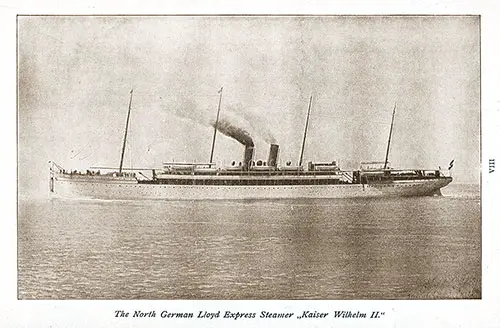
Express Steamer SS Kaiser Wilhelm II. Guide Through North and Central America, April 1898. GGA Image ID # 1ddf907e5f
On June 26, 1881, the first fast steamer was placed upon the line. She was followed in 1882 and 1883 by the Werra and the Fulda (16-17 miles), in 1884 by the Ems (17 miles), in 1886 by the Aller, the Trave, and the Saale (17-18 miles), in 1888 by the Lahn (19 miles), in 1889 by the Kaiser Wilhelm II, and 1890 by the Spree and the Havel (19-20 miles).
The construction of the fast steamers also inaugurated a change in the interior arrangements of the vessels; the old-fashioned monotonous dining rooms with a number of tables in file flanked on each side by uncomfortable benches were replaced by saloons of studied elegance and sumptuousness.
In the modern dining saloons, furniture, carpets, curtains, and paintings combine to form an artistic whole with the architectural disposition of the rooms—the firm of A. Bembé of Mainz executed the whole outfit of the saloons after the designs of the Bremen architect Poppe.
The period during which the fleet of fast-steamers of the Lloyd was constructed coincides with another important phase in the development of German transoceanic trade, namely the establishment of the subsidized mail steamer service to Eastern Asia and Australia; in July 1885, the North German Lloyd contracted with the German government to carry on the service on all the Imperial mail-steamer lines which Parliament had decided should be established with the provision that all the new steamers to be placed on such lines should be built in German shipbuilding yards.
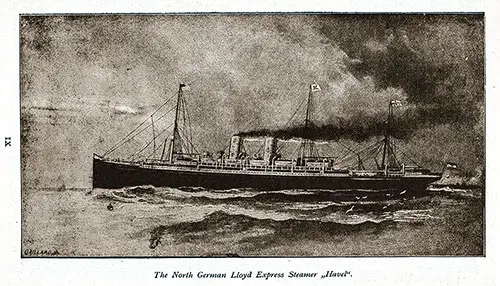
Express Steamer SS Havel of the Norddeutscher Lloyd. Guide Through North and Central America, April 1898. GGA Image ID # 1de03ffe9b
The speed contracted was 12 miles for the line to Eastern Asia and the Mediterranean line, 11 1/2 miles for the Australian main line, and the other branch lines.
The new mail steamer service consisted of
- Main-line to Eastern Asia
- Main-line to Australia
- Branch-line Trieste-Brindisi-Alexandria
- Branch-line Hongkong-Japan
- Branch-line Sydney-Tonga Islands-Samoa Islands
Preparations for the opening of the new important services were accelerated so that as early as 28 June 1886, the first Imperial mail steamer, the Oder, could leave Bremerhaven to carry the German flag to the shores of Eastern Asia. The new steamers Stettin and Lübeck built for the branch lines had already left Bremerhaven sometime before.
The Imperial Mail Steamer Service
As the steamers Lloyd possessed at the time of concluding the contract were inadequate in number and construction to the requirements of the new service, the company at once ordered three steamers for the main lines and an equal number for the branch lines of the Vulkan shipbuilding yards at Stettin. The new steamers, Preussen, Bayern, Sachsen and Stettin, Lubeck, and Danzig, exceeded the provisions of the contract with the government regarding dimensions and speed.
During the first years of the Imperial mail-steamer service, some changes became necessary. In the first place, the line between Trieste, Brindisi, and Alexandria was rendered impossible due to the sanitary conditions prevailing in Egypt. This line was, therefore, replaced by a line from Brindisi to Port Said. The latter existed until the year 1893 when the Mediterranean branch service was given up altogether, as it was decided that the steamers of the main lines should, in addition to Genoa (where they had called since 1887), also touch at Naples for the embarkation of mails to ensure a speedy despatch of the latter.
In a strategic move, Parliament decided in 1893 to discontinue the Pacific branch line, which had proven to be of little practical value. Instead, a new branch service was established, running from Singapore via Batavia to German New Guinea. This decision underscored the service's commitment to practicality and efficiency, aligning its operations with the changing needs and circumstances.
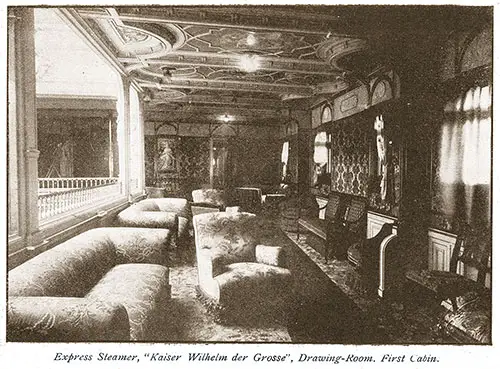
First Class Drawing Room on the Kaiser Wilhelm der Grosse. Guide Through North and Central America, April 1898. GGA Image ID # 1de0c65e48
The service of the Imperial mail lines soon showed prospects of a hopeful future. The fears, expressed on various sides that the country's subsidy would only benefit the commerce of other nations, that German commerce would derive no profit from it, and that the interests of the already existing lines of steamers owned by private firms would be seriously injured, all proved without foundation.
From the beginning, the offer of cargo for the steamers was considerably in excess of the room available. The increase in German exports to the countries concerned has been so rapid that no doubt as to the favorable influence of the lines can be further entertained. The interests of the lines carried on by private firms have not been injured; rather, the contrary has taken place.
As proof of this, we beg to call the attention of our readers to the figures, which they will find subjoined. German exports to China amounted to 14 1/2 million marks in 1887, against 47 million in 1893. During the same period, the exports to Japan rose from 4 1/2 million to 26 million, and the exports to Australia increased from 17 million to 114 million.
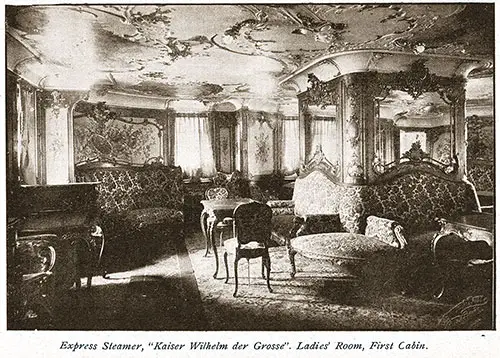
First Class Ladies Room on the SS Kaiser Wilhelm der Grosse. Guide Through North and Central America, April 1898. GGA Image ID # 1de0cd5644
Regarding the lines carried on by private firms, the German Kingsin line to Eastern Asia existed before the Imperial mail lines were founded. This line dispatched a steamer every four weeks; but in 1887, one year after the opening of the Imperial mail lines, the Kingsin line found itself compelled to double its service. As regards the trade to Australia before the opening of the Imperial mail lines, there existed only one line, the Sloman line.
This line was of comparatively little importance to German commerce, as the steamers used to embark their cargo chiefly in Antwerp and London and only in exceptional cases sailed directly to German ports when returning. The Sloman line has, it is true, since its service was suspended. Still, in its place, a new company, the Australian steamship company, was founded only three years after the inauguration of the Lloyd Lines. The German Australian company likewise maintains a fortnightly service with Australia.
Larger Steamers and Enlarging the Existing Fleet
The steamers soon proved too small for the goods offered regarding the Imperial mail lines. Still, these lines were completely provided with much larger steamers a few years ago.
The alterations in the construction of some of the vessels, as well as the new additions to the fleet, which for this purpose were ordered by Lloyd, on the one hand, represent a work in the art of shipbuilding, never undertaken before to such an extent, and on the other, have created a new type of steamer which gives the fullest satisfaction.
In the latter respect may be mentioned the twin screw steamers Prinz Regent Luitpold and Prinz Heinrich were built by F. Schichau of Danzig, As regards the reconstructions effected, the most remarkable work is the lengthening of the steamers Bayern, Sachsen and Preussen carried out by the firm of Blohm & Voss in Hamburg.
Each of the three steamers was placed in a floating dock and cut through amidships just forward of the engines. The forepart of the steamer was then drawn forward by hydraulic force, and a new compartment was built between the two separated parts of the vessel. -- In this way, the SS Sachsen and SS Bayern were lengthened by fifty feet, and the SS Preussen was lengthened by seventy feet.
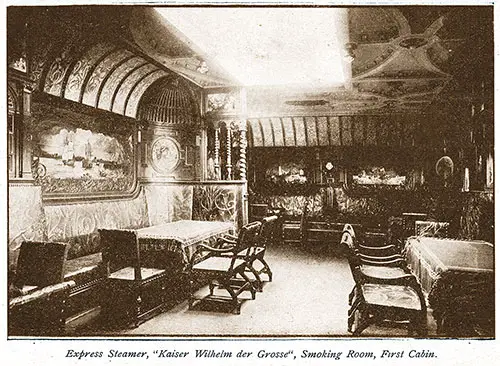
First Class Smoking Room on the SS Kaiser Wilhelm der Grosse. Guide Through North and Central America, April 1898. GGA Image ID # 1de11ffd3d
The tonnage of the two former steamers saw a significant increase, with each vessel gaining about 2000 cubic meters. The Preussen, in particular, experienced a substantial growth of about 2500 cubic meters. Remarkably, this expansion did not compromise the speed of the steamers, showcasing the impressive engineering behind their lengthening.
At the end of this article, our readers will find some statistical tables. These tables show the development in passenger and goods traffic, providing a clear picture of the increase or decrease in traffic over the years. They also show the tonnage employed on the Imperial mail lines, giving insights into the capacity of the transportation system.
In 1892, the North German Lloyd started a unique service of cargo steamers between Bremen and New York and between Bremen and Baltimore. This service was unique because it allowed the steamers to profit from the completed work of deepening the Weser to land and embark goods at Bremen instead of at Bremerhaven.
For the latter, denominated the Roland line, a number of new steamers were built. The line from Bremen to Baltimore has been formed by the large steamers of the München class, all built as recently as 1889 and 1890. These two lines carry passengers and goods, and the Baltimore steamers also take a limited number of cabin passengers.
The 1890s: The Newest and Largest Vessels
Since 1890 the traffic with New York has been further developed by the opening of a line of fast-steamers from New York via Gibraltar to Genoa and Naples, with occasional calls during the winter season at Algiers, Return tickets for the line Bremen and New York can be made available for the Mediterranean line and vice versa, the passengers being at liberty to choose that route which according to the season and their plans best suits them.
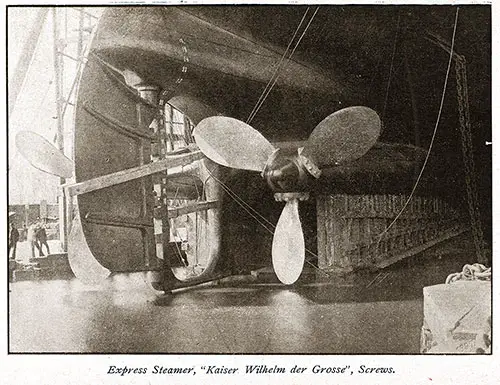
View of the Screws on the SS Kaiser Wilhelm der Grossse. Guide Through North and Central America, April 1898. GGA Image ID # 1de1180b8d
Since 1890, traffic with New York has been further developed by the opening of a line of fast steamers from New York via Gibraltar to Genoa and Naples, with occasional calls during the winter season at Algiers. Return tickets for the Bremen and New York lines can be made available for the Mediterranean line and vice versa, with the passengers being free to choose the route that best suits them according to the season and their plans.
During the past two years, 1896/1897, the North German Lloyd has placed in service a considerable number of new vessels of the largest dimensions, retired and disposed of its older steamers, and thus completed the rejuvenation of its large fleet so that it now controls a steamer material fitted to meet all possible requirements and is in no respect surpassed by that of any other Company.
Among the new vessels deserving special mention are the four large steamers of the Barbarossa class, each 550 feet long, 10500 tons capacity, and 20000 tons displacement. They are twin screw steamers driven by two wholly separated sets of engines of from 7000 to 8000 horsepower,
A unique new feature of these steamers is the arrangement of the two enormous promenade decks, one above the other, giving the vessels an imposing and distinguishing appearance.
The staterooms are all situated above the main deck, in the best possible location, and have won immediate favor with the traveling public because of their unusual size, comfortable arrangement, and superior ventilation.
The Barbarossa steamers are employed in the summer service between Bremen and New York and in the Australian service during the Winter.
The Express Steamship Kaiser Wilhelm der Grosse
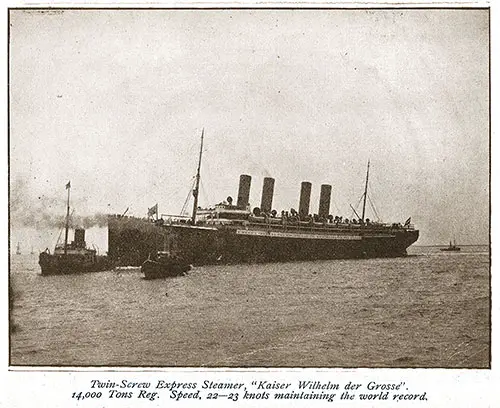
Twin-Screw Express Steamer SS Kaiser Wilhelm der Grosse of the Norddeutscher Lloyd. Guide Through North and Central America, April 1898. GGA Image ID # 1de051eab0
In addition, toward the end of last year, 1897, the new twin screw Express Steamship Kaiser Wilhelm der Grosse was placed on the line between Bremen and New York. Its superior arrangements and achievements have aroused the greatest interest and sensation worldwide.
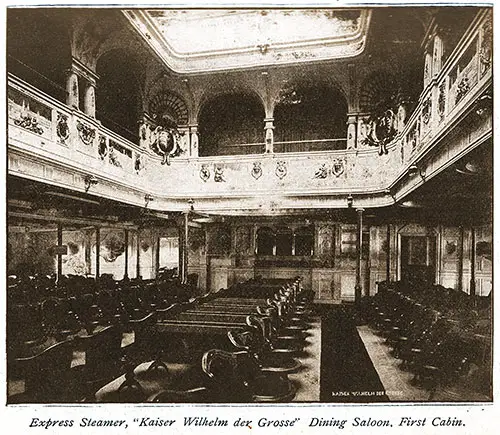
First Class Dining Saloon on the SS Kaiser Wilhlem der Grosse. Guide Through North and Central America, April 1898. GGA Image ID # 1de09dbd97
The Kaiser Wilhelm der Grosse has a length of 648 feet overall, 66 feet beam, and 43 feet depth, is of 14350 register tons and 20 000 tons displacement. The vessel is designed to carry 400 First Class, 350 Second Class, and 800 Third Class passengers and has a crew of 500. The Kaiser Wilhelm der Grosse is the largest and the most superb steamer now afloat.
In design and equipment, the interior appointments of the steamer, the saloons, reading rooms, smoking rooms, drawing rooms, etc., are distinguished by their unexcelled artistic arrangement.
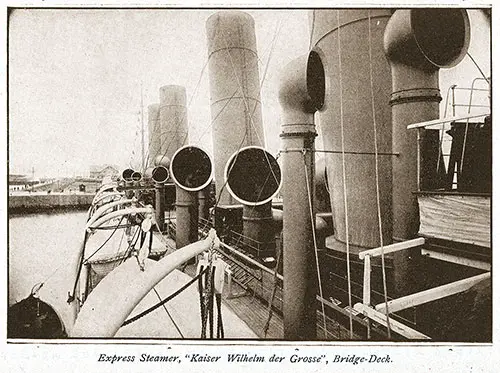
View from the Bridge Deck on the Express Steamer SS Kaiser Wilhelm der Grosse. Guide Through North and Central America, April 1898. GGA Image ID # 1de0591674
The two powerful engines, with a combined horsepower of 30,000, give the vessel a speed of 21 -22 miles an hour. The first trip from Southampton to New York took 5 days, 22 hours, and 35 minutes, and the home trip from New York to Plymouth took 5 days, 15 hours, and 10 minutes. The average speed was 21.39 and 21.91 miles an hour, respectively.
The best performance for a single day was a run of 567 miles, equaling a speed of 23 miles an hour. The best speed on the third voyage from New York to Southampton was 22.35 knots, giving the steamer the best single-day record and the best average record in the world.
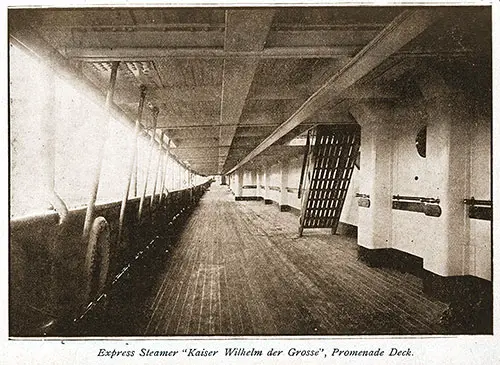
First Class Promenade Deck on the SS Kaiser Wilhelm der Grosse. Guide Through North and Central America, April 1898. GGA Image ID # 1de0fd97df
A second twin-screw Express steamship of about the same size as the Kaiser Wilhelm der Grosse, the Kaiser Friedrich, will be placed in the service between Bremen and New York in the Spring of 1898.
The South America Trade
Trade with South America has also considerably increased during the last few years, with some new and comfortable steamers mainly constructed for that purpose.
First, we ought to mention the two new saloon steamers Mark and Pfalz, which, provided with all modern improvements for a voyage in the tropics, form quite a new type of tropical steamer. Their construction also allows them to steam up the river as far as Bremen and to be dispatched from the latter place instead of from Bremerhaven.
Besides the steamers mentioned, the company has placed upon the River Plate line the twin screw steamer H. H. Meier and Wittekind.
The company further maintains a regular service by passenger and cargo steamers to Brazil (Pernambuco, Bahia, Rio de Janeiro, and Santos). The passenger steamers leave Bremerhaven on the 10th and the cargo boats on the 25th of each month; in connection with the arrivals and departures of the steamers from Santos, the North German Lloyd has recently opened a branch service for passengers and goods with calls at Paranagua, San Francisco, Desterro and Rio Grande do Sol.
Summary and Conclusion
In conclusion, we should mention that the company maintains a regular summer service to the North Sea Islands Norderney, Borkum, and Heligoland. In connection with these lines, fast express trains are run to the principal inland places. These trains are dispatched from and arrive at the Lloyd Halle in Bremerhaven, which is in immediate connection with the steamers' landing place.
In the preceding sections, we have given a short sketch of the company's rapid growth. Subjoined, our readers will find a list of the various lines of the North German Lloyd at present in operation:
I. Traffic to North America:
- Line of fast steamers from Bremen to New York via Southampton and Cherbourg. Steamers employed on this line: Kaiser Wilhelm der Grosse, Kaiser Friedrich, Havel, Spree, Zahn, Aller, Trave, Saale, Departures from Bremen Tuesdays and Saturdays, from Southampton or Cherbourg Wednesdays and Sundays.
- A line of fast steamers runs from Genoa and Naples via Gibraltar to New York, with occasional calls at Algiers. Steamers running on this line are Kaiser Wilhelm II, Werra, Fulda, and Ems.
- Line of twin screw mail - steamers from Werra to New York (steamers of the Barbarossa type).
- Line of mail steamers from Bremen to Baltimore (steamers of the München type). Weekly, Thursday.
- Line of mail steamers from Bremen to Galveston.
II. Traffic to South America:
- Bremen -- Brazil via Antwerp, Oporto, Lisbon to Pernambuco, Bahia, Rio de Janeiro, and Santos by the steamers Coblenz, Main, and Trier.
- Bremen-- River Plate via Antwerp, Southampton, Corunna to Montevideo and Buenos Aires. Saloon-steamers: Mark, Pfalz, H. H. Meier and Wittekind.
- Bremen --Eastern Asia via Antwerp, Southampton, Genoa, Naples, Port Said, Suez, Aden, Colombo, Singapore, Hong kong Shanghai. Steamers: Prinz Heinrich, Preussen, Sachsen and Karlsruhe.
- Bremen--Australia via Antwerp, Southampton, Genoa, Naples, Port Said, Suez, Aden, Colombo, Adelaide, Melbourne to Sydney, Steamers: Prinz Regent Luitpold, Barbarossa, Friedrich der Grosse, Königin Louise, Bremen etc.
- Branch Line from Hong kong to Japan, Hong kong, Yokohama. Hiogo, Nagasaki and return to Hong kong Steamer : Hohenzollern.
- Branch Line from Singapore to German New Guinea. Singapore, Batavia, Soerabaya, Friedrich Wilhelmshafen, Stephansort, Finschhafen, Herbertshohe and Matupi. Steamer: Stettin.
IV. Branch Line in Asia:
- From Singapore to Deli Sumatra. Steamer: Sumatra.
V. European Lines:
- Tow-boat service from Bremen to Hamburg.
- Saloon steamer service is available from Bremen to Norderney and Borkum during the bathing season.
- Saloon-steamer service (luring the bathing-season to Heligoland
For service on 311 of these lines, the North German Lloyd now owns a fleet of 82 steamers and 84 lighters, with a total tonnage of over 300,000, including the steamers in construction.
The fleet's crews represent a force of about 5,500 men. One of the tables at the end of this article shows how many persons in each grade this number is composed.
The maintenance of so many lines and so numerous a fleet, of course, rendered it necessary that the arrangements on shore should be proportionate. First, we should mention the extensive docks and workshops for the execution of repairs at Bremerhaven; these comprise a graving dock and other works with all modern appliances for marine engineering.
The number of men constantly employed in the workshops of the North German Lloyd at Bremerhaven is about 1000. The repair works at Bremerhaven are supplemented by an establishment of a similar kind at Bremen but of a less extensive character.
The considerable traffic of passengers by the steamers of the North German Lloyd has further developed an institution for the provisioning of the steamers, which in its arrangements and extent surpasses all similar establishments of other companies.
The consumption of provisions and beverages on the steamers of the Lloyd annually reaches a value of more than 6 1/2 million marks. The annual consumption of coal is about 750,000 tons.
Connected with the establishment for the provisioning of the steamers is the steam laundry, in which the whole ship's linen is washed and disinfected after the return of the steamers to Bremen.
The North German Lloyd also has its piers in New York. This powerful organism is controlled by the Company's head office in Bremen. -- In order to simplify service and secure prompt business despatch, the following departments have been created: Central Office, Passage Department, Freight Department, Provisioning Department, Insurance Department, and River Navigation Department.
The Company has provided for the welfare of its seamen and other employees as well as the widows and orphans of its servants by creating a pension fund. This fund has existed for several years and now possesses a capital of two million marks.
On 1 January 1893, this institution was extended to include a separate pension fund with increased endowments for widows and orphans.
Most of the seamen of the North German Lloyd have spent many years in the service of the Company. Of the total number of 4874 seamen employed on the steamers, only a portion not amounting to 25% are in their first year of service, whereas 18% are between their tenth and thirtieth year of service in the Company, as shown by the affixed table all important posts are in the hands of tried and experienced men.
The numerous reports of successful cases of rescue effected at sea by the crews of the North German Lloyd are a proof of the excellent spirit which animates them.
The inimitable Mark Twain, in one of his happy moments, has aptly and deservedly added his invaluable testimony to the sterling worth and inestimable working capacity of the North German Lloyd in the following private letter to a friend:
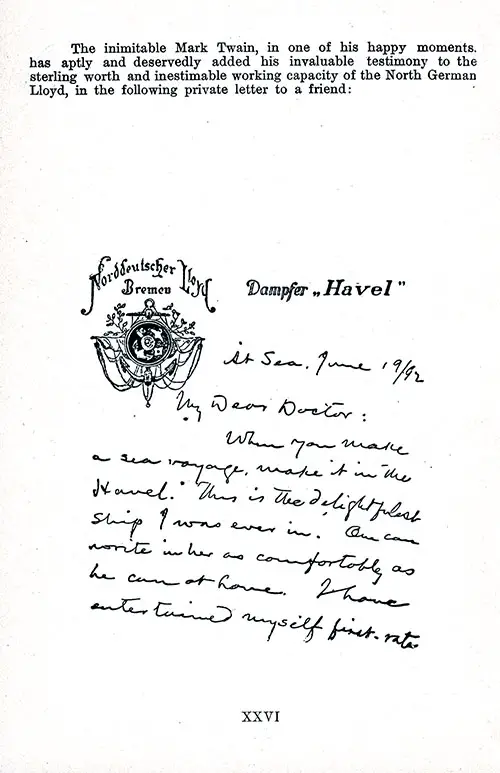
Testimonial from Mark Twain (Samuel Langhorne Clemens), Part 1 of 2, 19 June 1892, On Board the SS Havel. Guide to North and Central America, North German Lloyd, 1898. GGA Image ID # 215c9a3b98
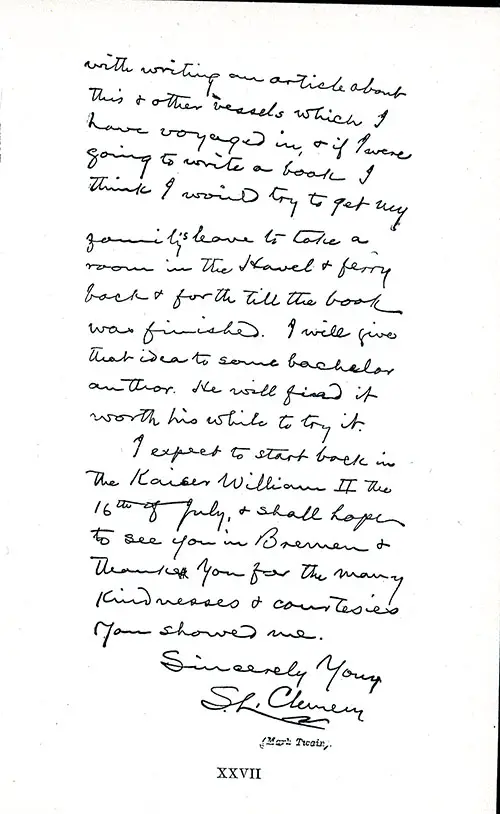
Testimonial from Mark Twain (Samuel Langhorne Clemens), Part 2 of 2, 19 June 1892, On Board the SS Havel. Guide to North and Central America, North German Lloyd, 1898. GGA Image ID # 215cc358d1
In conclusion, we beg to translate a letter addressed to the Company by His Majesty, the German Emperor, in recognition of its services.
"During my voyage today from the mouth of the Weser to Wilhelmshafen on board the fast-steamer "Lahn," I had an opportunity to inspect the vessel in all her parts and minutely observe how the service is carried out. I have the pleasure of expressing to the management of the Company my full satisfaction with what I have seen on board this steamer. In remembrance of the voyage and as it is the first time that my standard has been hoisted on board a German merchantman, I will present this standard to the North German Lloyd with a desire that the good spirit which rules on its steamers may always be maintained."
On board of the Express Steamer "Lahn".
Wilhelmshaven, 22nd April 1890.
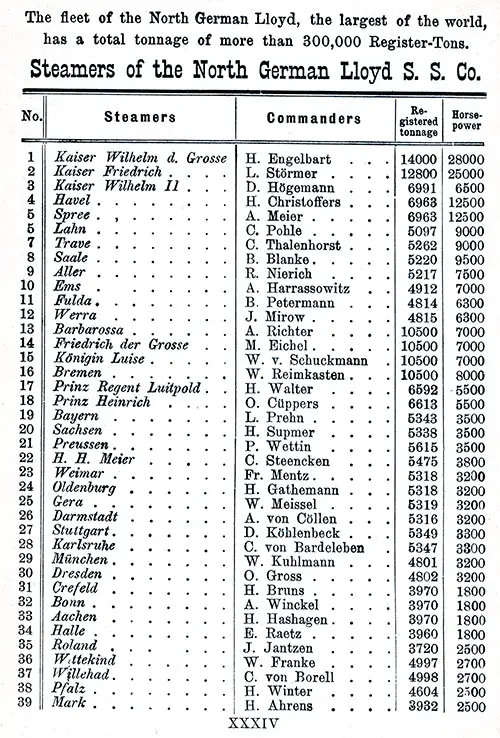
The Norddeutscher Lloyd's fleet is the Largest in the World and has a Total Tonnage of More Than 300,000 Registered Tons. Steamers of the North German Lloyd Steam Ship Company, Part 1 of 2. Table Includes Name of Steamship, Commander, Registered Tonnage, and Horsepower. Guide to North and Central America, North German Lloyd, 1898. GGA Image ID # 215d2a4196
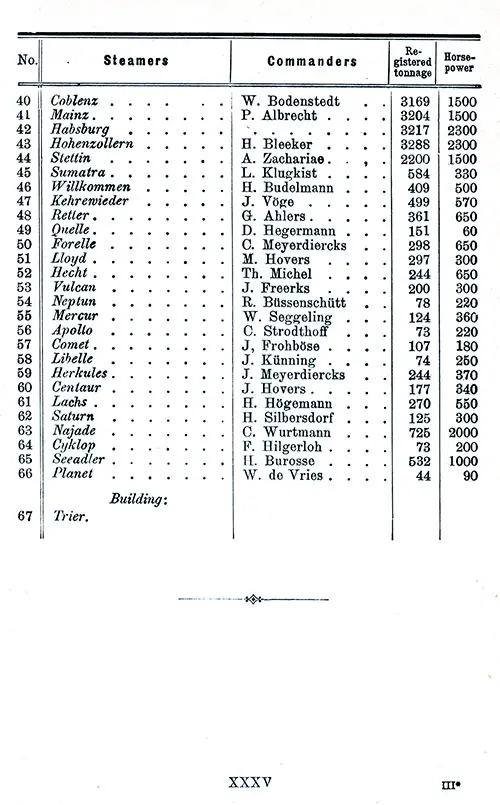
Steamers of the North German Lloyd Steam Ship Company, Part 2 of 2. Table Includes Name of Steamship, Commander, Registered Tonnage, and Horsepower. Guide to North and Central America, North German Lloyd, 1898. GGA Image ID # 215d8e4198
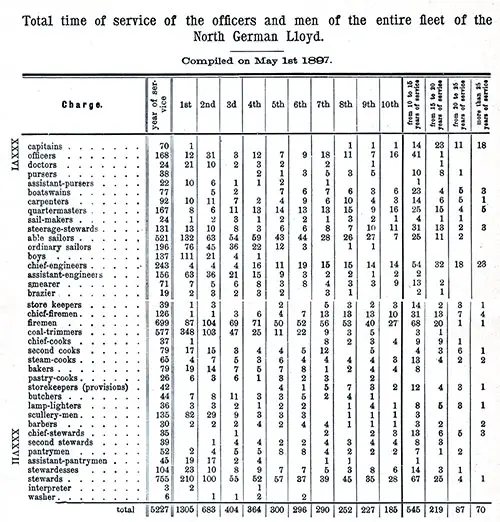
Total Time of Service of the Officers and Men of the Entire Fleet of the Nordeutscher Lloyd, Compiled on 1 May 1897. Table Includes Rank or Position, [Total] Years of Service, 1st-10th (Rank?), Number of Staff with 10 to 15 Years of Service, 15-20 Years of Service, 20-25 Years of Service, and More Than 25 Years of Service. Guide to North and Central America, North German Lloyd, 1898. GGA Image ID # 215d9dac93
